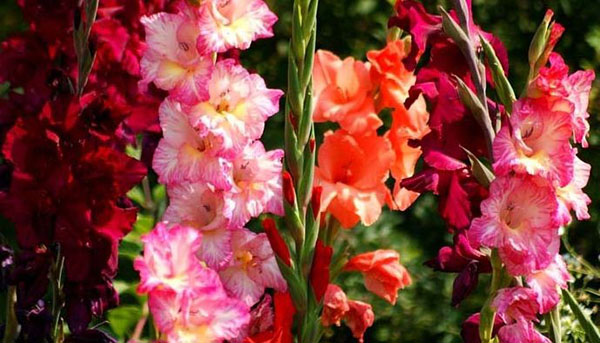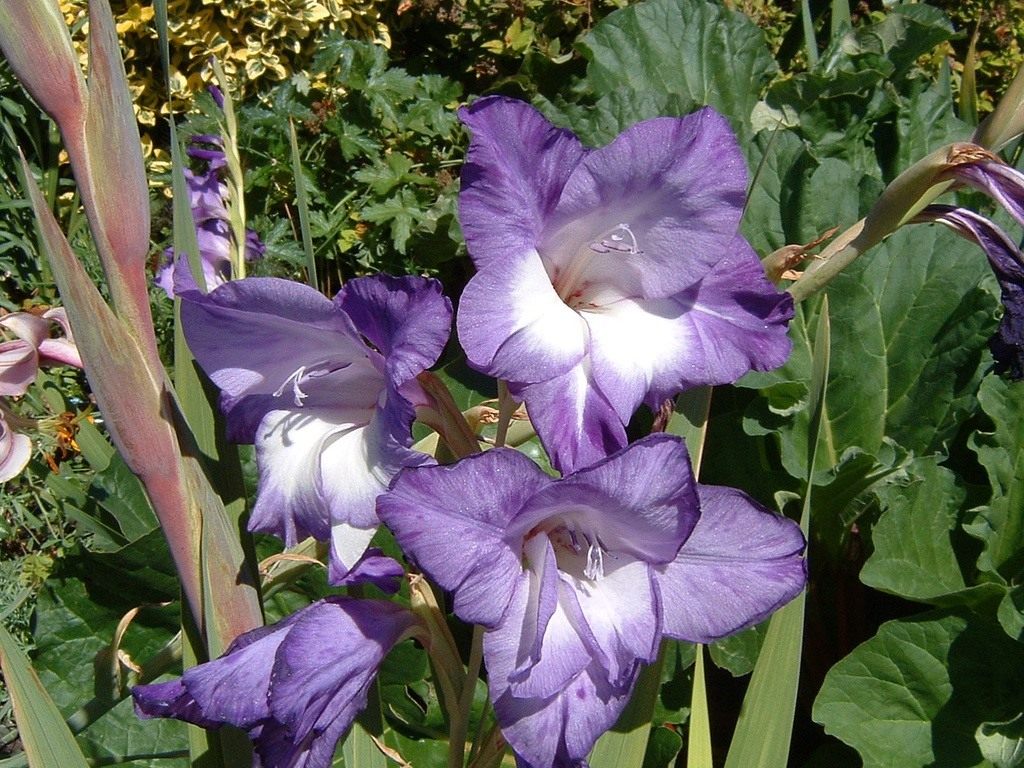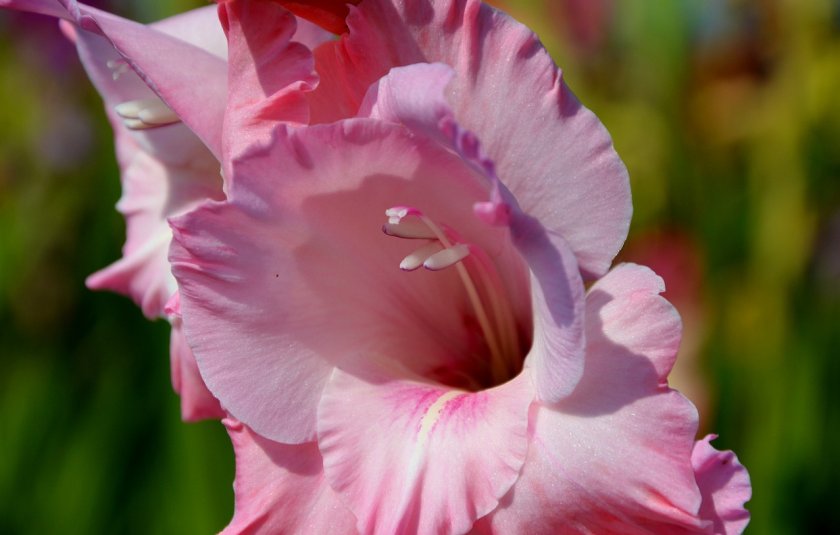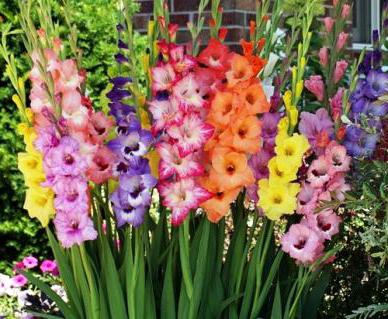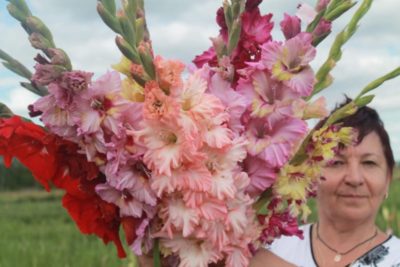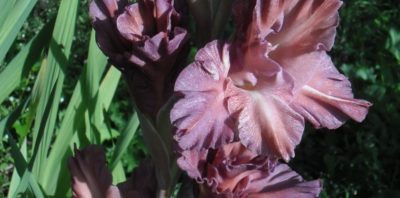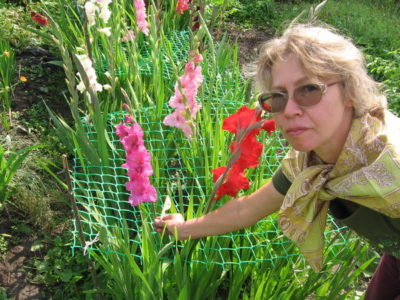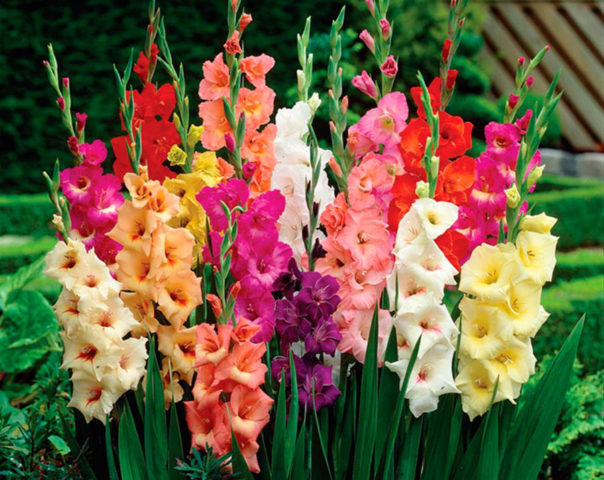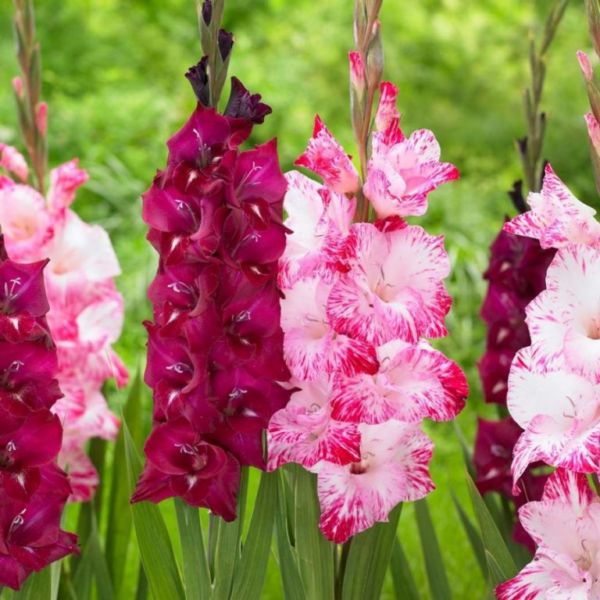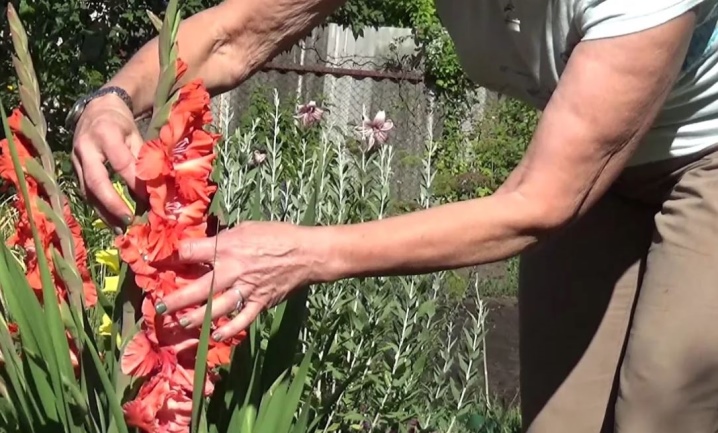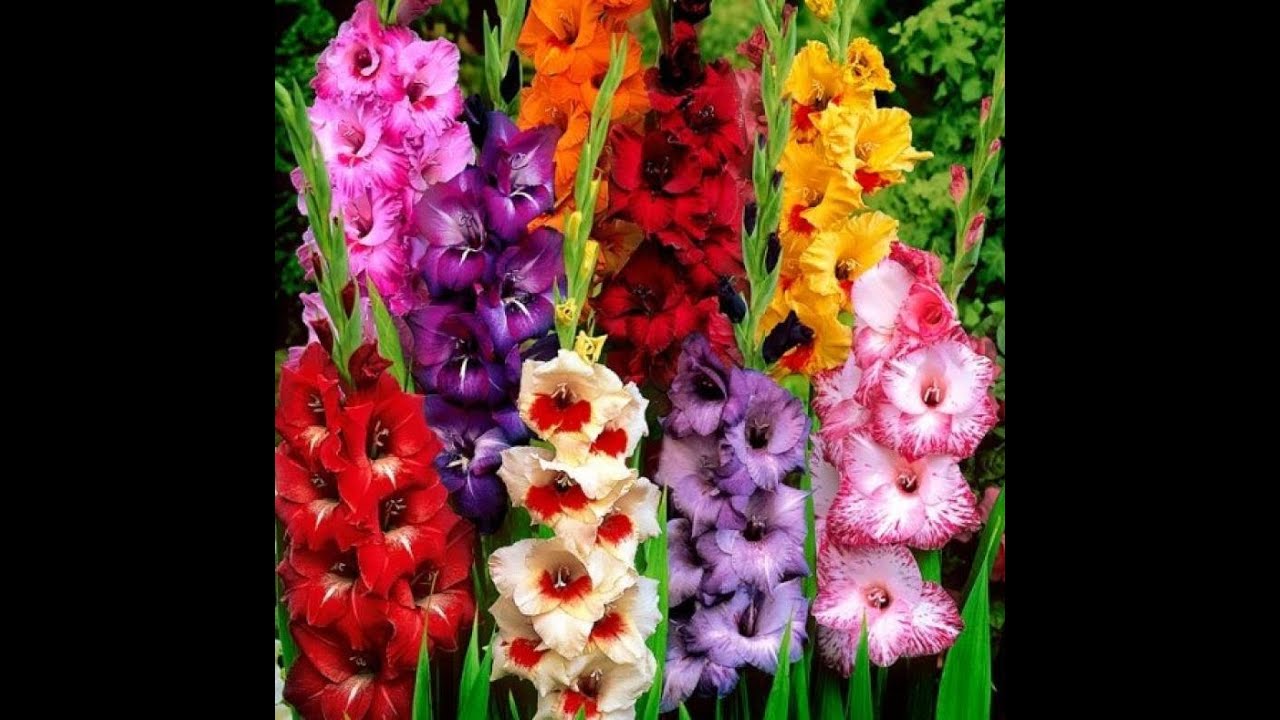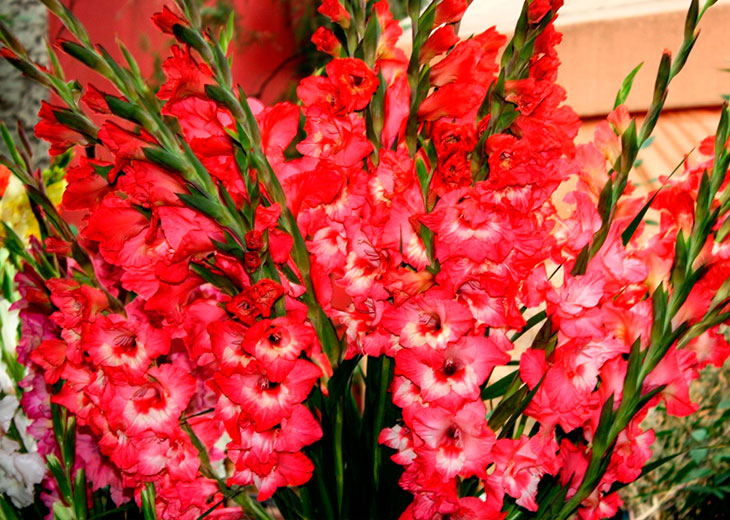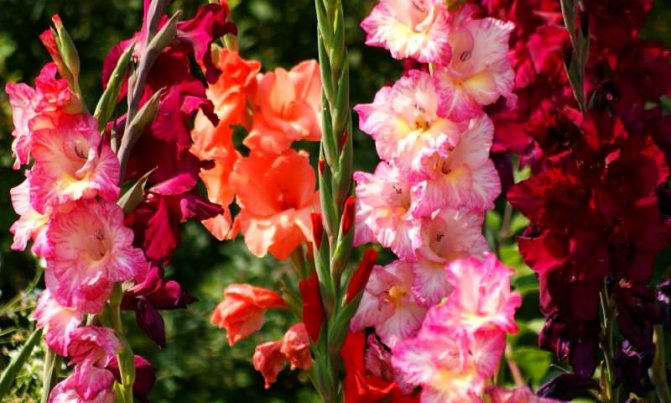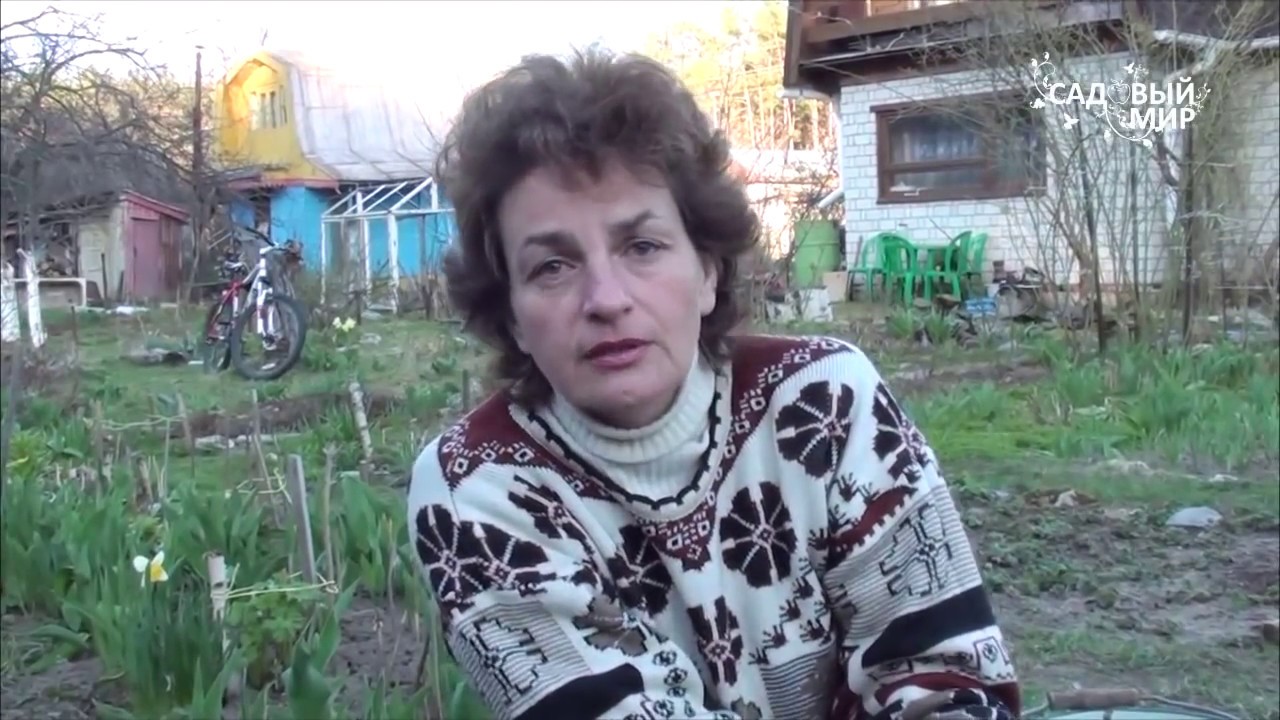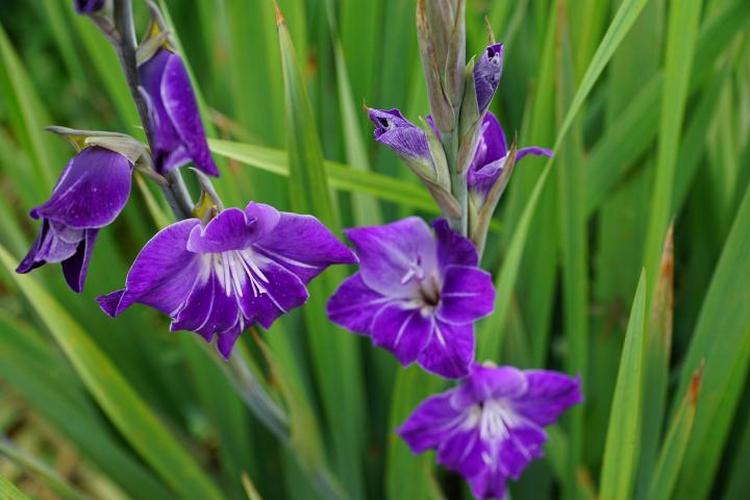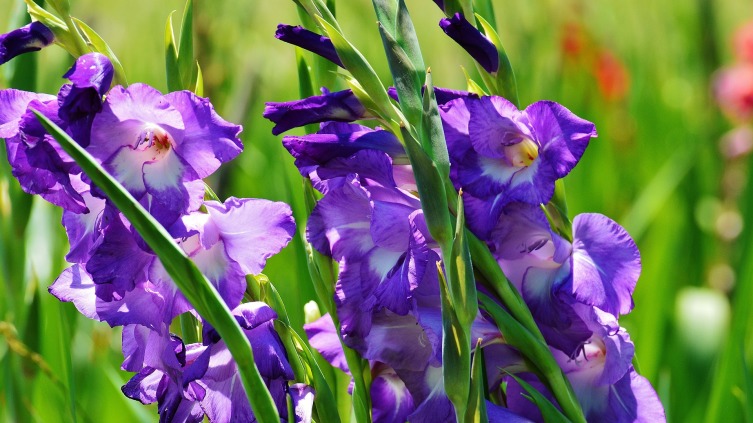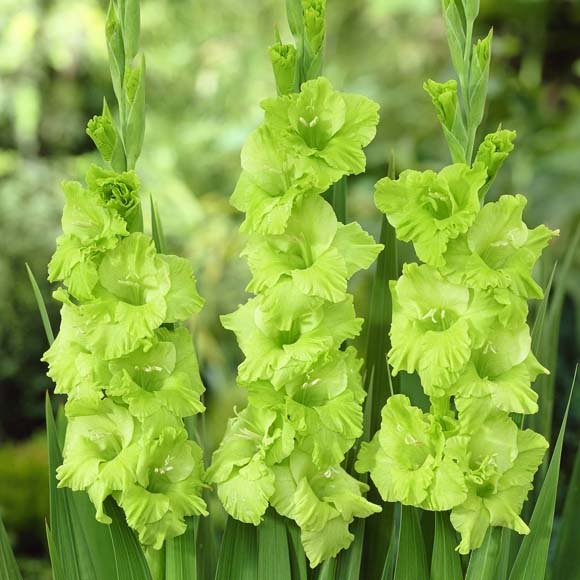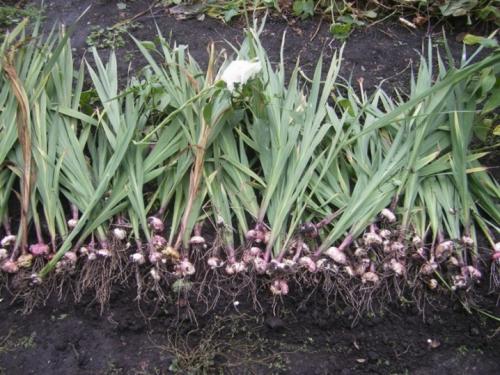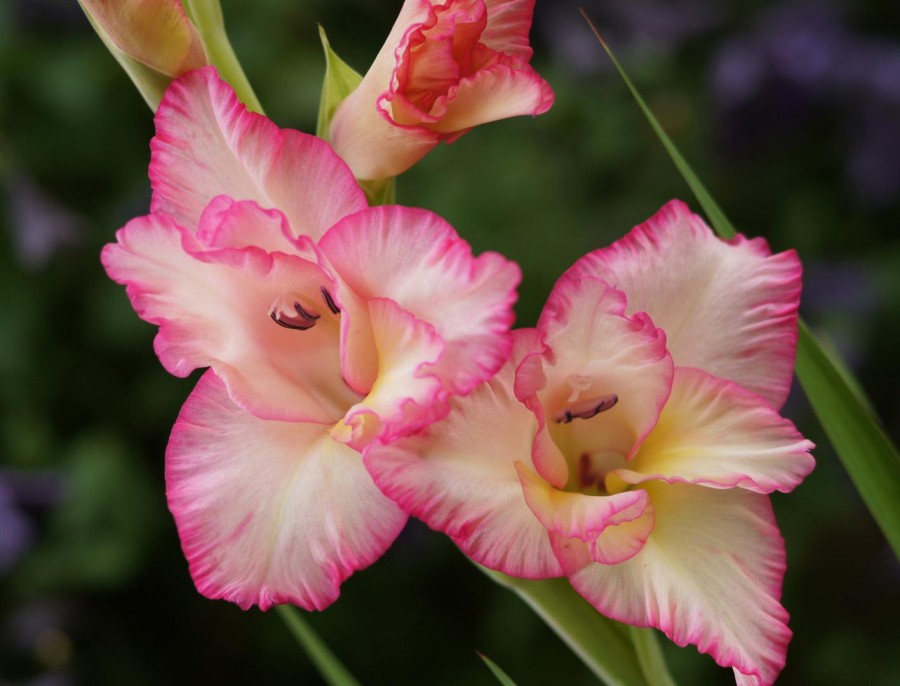How long does the baby of gladiolus grow? 2 We plant tubers at home
To obtain a good harvest, flower growers recommend selecting the largest and healthiest bulbs, with a dense and as dry shell as possible. From such children, the crop is obtained already in the first growing season. This does not mean that smaller fruits are not capable of active reproduction, but the first flowers from them will appear no earlier than 2-3 years after planting. The optimal size of tubers for growing gladiolus at home is at least 7-9 millimeters in diameter.
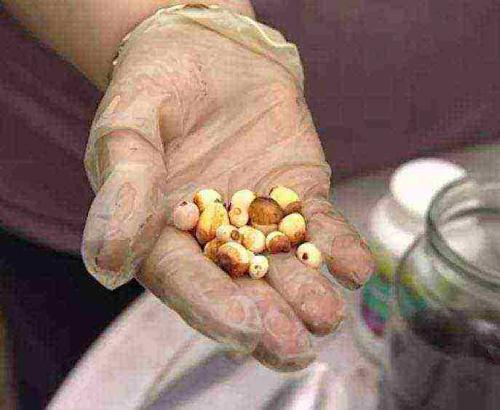
In order to grow healthy gladioli from children, it is very important to choose not just large fruits, but also pay particular attention to the presence of root tubercles on the kidney, the more their number, the better the final planting material will turn out. It is advisable to store young kidneys at room temperature in a place well protected from excess light; with proper storage, gladiolus babies can retain their properties for several months
Approximately 15–20 days before planting, pre-selected babies must be thoroughly peeled. Further, for preventive purposes, the bulbs are placed in loose gauze bags, having previously divided them into varieties, after which they are dipped into a solution of warm water and potassium permanganate in a proportion of 5-7 grams. substances per 10 liters. water.

The soil for planting must first be well moistened, then loosened. Sowing gladiolus tubers in a garden plot can be done in two ways - shallow or deep, depending on the structure and composition of the soil. In heavier or clayey soil types, they are planted to a depth of no more than 3-4 centimeters. In looser and lighter soil, you can plant them deeper, in planting grooves measuring 7-9 centimeters.
In this case, the distance between the planted fruits should not be less than 5-7 centimeters, with a distance of 15-20 cm between the rows of planting, if the planting is carried out on previously prepared beds. As for the landing frequency per 1 sq. meter, then it directly depends on the climatic conditions of a particular region and the illumination of the site. To determine which frequency is right for your companion, we recommend that you divide the planting material into several parts and varieties, and plant them at different frequencies, and in the fall, based on the quantity, it will be possible to draw an optimal conclusion.
After planting, it is best to mulch the beds with a small layer of cut grass (1-2 centimeters). Next, you need to carefully water the beds and cover the planting sites with plastic wrap or other material suitable for mulching. This contributes to better tuber preservation and acceleration of the germination process. Subject to the listed sequence of actions and recommendations, the first shoots in a normal season are obtained in 20-25 days.

Planting GLADIOLUS children before winter. Planting and caring for gladioli outdoors
It is necessary to plant gladioli in the country in the lightest and most protected from the wind area. These powerful and tall flowers require a lot of sun, and their long stems can easily deform or break under constant exposure to strong winds.
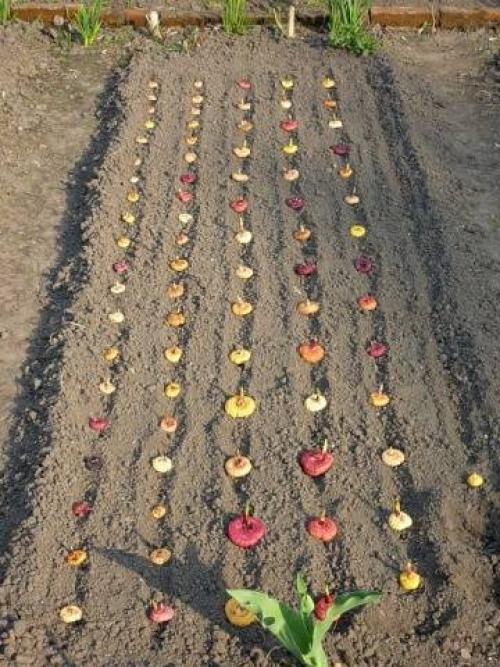
Important! It is better to choose the highest place on the site for planting - waterlogging is contraindicated for gladioli, these flowers are susceptible to infection with fungal infections. Therefore, swampy lowlands are not suitable for them.
It is not recommended to grow gladioli in the same place for several seasons in a row - scab and fungi that infect these flowers can remain in the ground for several years.
The depth of the planting groove depends on the size of the bulb. The tubers do not need to be buried too deep, this can cause later flowering. The ground should be well warmed up - it is optimal if the ground temperature is more than 8 degrees at a depth of 10 cm.

To protect the bulbs from scab, sawdust washed with a special solution is poured into the bottom of the groove. It is recommended to mulch the soil from above to prevent the appearance of weeds, slugs and prevent the soil from drying out.
In order for the bulbs to germinate as quickly as possible, they are covered with plastic wrap. You need to remove the shelter immediately after the appearance of greenery. They also protect gladioli from possible frost and heavy rain.
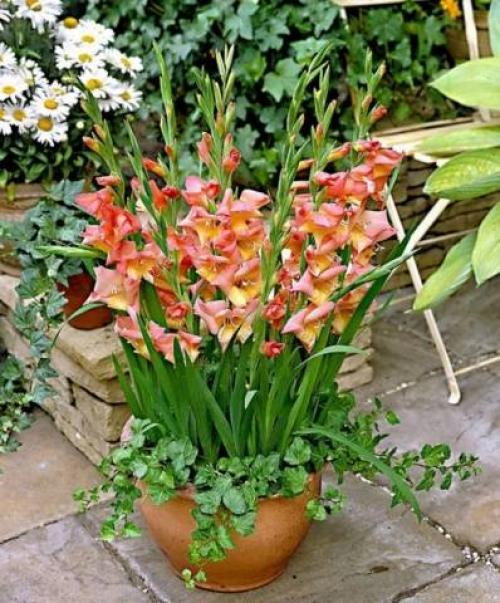
Attention! The soil for these flowers is needed with neutral or weak acidity. Chernozem with a small amount of sand or clay is best suited
You can add rotted humus or peat if the ground is too dense.
The planting of gladioli is over, now it remains to monitor the flowers, respond in a timely manner to their needs.
Feeding gladioli
Tall and powerful flowers need not only water and sun, for normal development, proper formation of flower ovaries, gladioli need to be fertilized regularly.
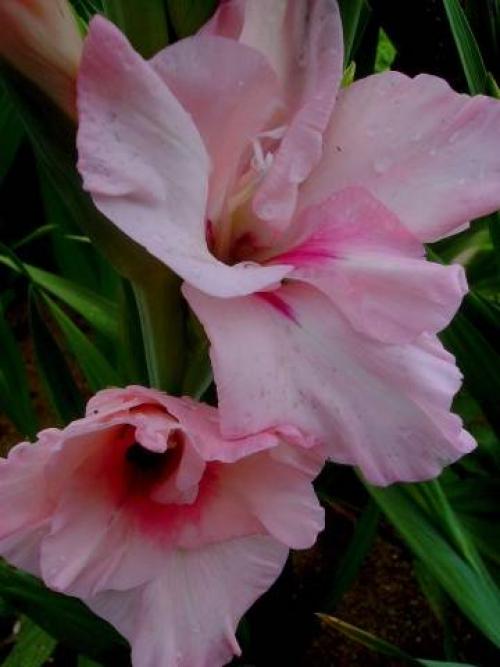
Fertilization of flowers begins from the moment the first pair of leaves appear on the stems, and continues until the last inflorescence:
- The first feeding of flowers is performed when the bulbs have just germinated and give two leaves. To do this, use nitrogen fertilizers that stimulate growth, which can be both mineral and organic. A weak solution of chicken manure, for example, works well.
- The same fertilizers or other growth stimulants are used at the stage of the third and fourth leaf formation.
- When there are 5-6 leaves on the bushes, you can feed the gladioli with a complex of fertilizers: nitrogen, potash and phosphorus. If the land on the site is rich in itself (black soil, for example), the nitrogen component can be excluded from the complex.
- When inflorescences begin to form, you need to repeat the fertilization with phosphorus and potassium. This stimulates the plants, they will be covered with large and bright flowers (as in this photo).
- In order to prolong flowering, you can add wood ash to the water for irrigation.
- In addition to other fertilizing, experienced gardeners recommend using additional green fertilizer every three weeks.
Fertilizers need to be applied regularly, but it is better to do this in small doses, dissolving nutrients in water for irrigation. High-quality feeding will help gladioli get stronger and please the gardener with abundant flowering.
Advice! Cut off faded gladioli or fresh flowers for bouquets using a sharp knife or pruner. The cutting line should be at an angle of 45 degrees, this is the least traumatic for the plants.
How to grow healthy and strong gladioli
The trouble with bulbous flowers is susceptibility to diseases and frequent damage to tubers by pests. Every year, the bulbs can accumulate bacteria and viruses, which will eventually lead to the death of the flower (the affected bulb is shown in the photo).

To prevent diseases, it is necessary to regularly process the bushes of gladioli. For these purposes, use:
- in the spring, before planting the bulbs in the ground, cut the garlic into small pieces and dig up the beds. After 2-3 days, you can plant gladioli. This will help protect plants from fungal diseases and their pathogens stored in the soil.
- Planting bulbs in sawdust helps against scab. Wood sawdust is pre-soaked in a nitrophene solution (a tablespoon of the substance per 5 liters of water). The joint planting of gladioli and viola, which scares away the causative agents of this ailment, helps well against scab.
- Until the gladioli have bloomed, it is possible to carry out a complex treatment of the bushes with copper oxychloride and karbofos. Copper-soap preparation and foundation is very helpful.
- After digging the bulbs in the fall, it is recommended to treat them with a 0.15% solution of potassium permanganate or 0.2% foundation.
When the bulbs do not need to be dug out

Gladioli should not be dug up and stored if the bulbs are rotten or infected. If the variety is rare and it is a pity to throw out the onion, you can cut off the damaged area and cover it with brilliant green. When infected with viral diseases (mosaic, ring spot), the planting material must be thrown away, pathologies cannot be treated. The onions should be thrown away if they deteriorate during storage - they become soft, covered with brown or greenish spots. Planting material should not be thrown away if the shell of the bulbs is cracked - the problem arises due to uneven development, when drought alternated with heavy rains in the summer season.
When cultivating gladioli, it is necessary to observe the terms of planting and harvesting planting material. Subject to the storage conditions, the onions overwinter well and will be ready for planting in the spring. If everything is done correctly, a flower bed with gladioli will delight you with lush flowering for many years.
Dividing the bulb
More experienced florists and summer residents are at risk to propagate gladioli by dividing the bulb. This will require certain skills and a stock of theoretical knowledge, otherwise the experiment will fail.
Features of the method
When dividing the maternal gladiolus bulb into several parts, you can get not only a larger amount of planting material, but also stimulate the formation of children. For manipulations, material is taken from the second or third year of life without signs of any disease or pest infestation.
How to exercise correctly?
Before you start cutting the onions, prepare tools and fixtures. The knife is sharpened well, burned on fire. The head is cut vertically. The number of pieces obtained depends on the size of the original bulb.
Each piece should contain not only a part of the bottom for the formation of new roots, but also living buds.
The cut sites must be disinfected and processed. Wood ash and brilliant green are used for such purposes. After that, the pieces of the onion are left to dry for a while, and then planted in the prepared nutrient soil. In the fall, ready-made, formed corms are dug up. Already next year they will give a large number of children, which are later used for reproduction and renewal of planting material. It is necessary to care for the cuttings planted in open ground in the same way as for an adult plant.
Plant the slices of the bulbs, preferably upside down. Ground shoots with this method develop more slowly, flowering often does not occur, but the formation of children is stimulated.
Gladioli have faded, what should I do next?
When gladioli fade, a completely fair question arises: "What to do next?" After all, leaving the tubers in the soil for the winter is unacceptable.
There are only a few representatives that can survive in the winter safe and sound. And then such options are permissible only in the warm climate of the region.
If the temperature in the region has dropped below -2 ° C, then the excavation should be carried out much earlier than the due date. Freezing a tuber will significantly weaken it, which means it will increase the likelihood of any disease occurring in winter.
What to do with gladiolus babies
Often, not very experienced gardeners, during the autumn digging of bulbs, clean off absolutely everything around the main tuber of the plant. However, this approach cannot be called correct.The fact is that small onions, also called babies, are a natural formation by which the plant reproduces.
Of course, some gardeners argue that there is no sense from these children - they say, they dry out very quickly and it is difficult to store them. In fact, this is not entirely true. With proper handling of children, winter storage does not take much effort. Moreover, they will all survive, in contrast to the same bulbs, which often deteriorate during wintering.
Let's take a look at the main reasons why you shouldn't throw away gladiolus babies together:
- When you first plant purchased gladiolus bulbs in your area, the plant's environment is alien. Naturally, it will still germinate and even give a peduncle, but at the same time it will be in a depressed state. In such a situation, the tuber is more susceptible to external negative influences, which can lead to diseases. If we talk about children, then they appear already completely adapted to your type of soil and are ready for active growth.
- Sooner or later, the gladiolus bulb will become unusable - the plant retains its properties for only about 5 years, and then problems begin with it. Children, on the other hand, allow you to generate new flower stalks.
- As noted above - children, this is a way of plant propagation. This means that with their help you can significantly increase the size of your collection, or even put them up for sale after developing into full-fledged tubers.
As you can see, the babies of gladioli are not at all useless tubers, but full-fledged rudiments for new healthy bulbs, which will also be adapted to your specific soil on the site.
 What to do with gladiolus babies
What to do with gladiolus babies
Gladioli - planting and care in spring
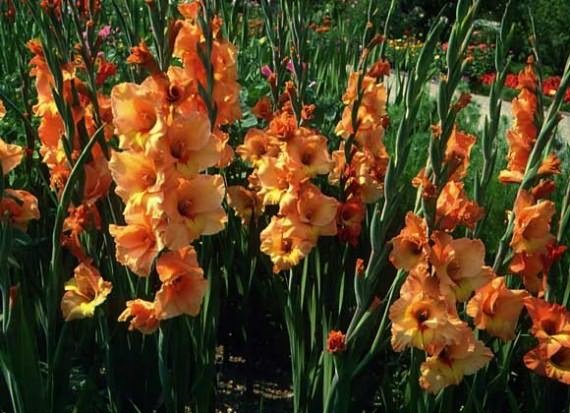
Gladioli are a real decoration of the garden in autumn. These gorgeous flowers are striking in their beauty and many colors, but in order for them to delight you in the fall, you need to know how to plant gladioli correctly in the spring. Although this flower is considered perennial, since it does not tolerate cold in the ground, for the winter, its tubers are dug up and stored indoors until the onset of heat.
In this article, we will consider the features of planting and caring for gladioli in the spring.
When to plant gladioli in spring?
The most optimal planting period for gladioli is May, when the ground warms up to + 10 ° C, but if there is a shelter from possible spring frosts, then you can plant them in April. Early varieties planted in June will bloom in August-September. Small corms and children are planted early so that they can grow up.
How to prepare gladioli for planting?
A month before planting, gladiolus bulbs are taken out of storage and carefully cleaned of scales so as not to damage the sprouts. At the same time, severely damaged and sick people are discarded. Small injuries are cut out with a sharp knife disinfected in alcohol, and then this place is treated with brilliant green or sprinkled with chopped charcoal. Then they are laid out in boxes or on a windowsill, where they will grow in a dry, warm and sunny place, but the roots will not form.
Before planting, the corms of gladioli are soaked for half a day in a solution with trace elements. They also need to be treated with pesticides in order to get rid of possible diseases and pests:
- from thrips and whiteflies, they are etched for half an hour in a solution of decis or fufanon;
- from fungi and bacteria, soak for 20-30 minutes in a 0.2-0.3% suspension of foundationol (topsin M) or 0.7% solution of potassium permanganate.
How plant gladioli correctly in spring?
A good spot is important when planting gladioli. It should be well lit, even or with a slight slope to the south, the ground should be loose and drained.
The flower does not like wind, stagnant water and shading. The shade on flowers in the morning delays flowering by 2 weeks, and in the evening by 3.Harsh gusts of wind can break the peduncles.
The best are: chernozem, light loamy or sandy loam soils. On clayey and heavy soils, it will be necessary to reduce the planting depth. The sites for gladioli must be changed every year, returning to one place no earlier than after 4 years.
The plot is dug up in the fall to a depth of 40 cm with the introduction of fertilizers (humus, up to 50 g / m² of superphosphate and 20-30 g / m² of potassium sulfate). In the spring, do it again and level it with a rake.
Gladioli are planted in beds directed from south to north at a distance of 15-20 cm between plants and 30 cm between rows. The usual embedding depth for large tubers is 8-12 cm, on heavy soils - 6-10 cm, and on light soils - up to 15 cm.

Good illumination in late July - early August allows flowers to grow by 3-12 cm per day.
Further care for growing plantings is as follows:
- regular watering, and with the formation of flowers and flowering - enhanced (10-15 liters of water per 1 m²);
- loosening the soil and hilling plants;
- top dressing with nitrogen fertilizers (20-30 g per 1 m²) one month after planting, with the second top dressing (after another 3-4 weeks) add another 25 g of superphosphate and 10 gr. potassium sulfate. The third time is fertilized during the formation of buds;
- before and after fertilizing, the plant is watered with water;
- weeding and mulching the soil retain moisture in the soil and inhibit the growth of weeds.
- tying to the support stretched along the rows. This can be replaced by hilling to a height of 10 cm.
- after cutting the flowers, it is necessary to leave at least 4 true leaves for the normal development of corms.
- timely removal of diseased plants.
Knowing all the intricacies of planting gladioli and caring for them in the spring, you can grow these bright and beautiful flowers of various shades on your garden plot.
.
What to do with gladiolus babies in the fall - recommendations of experienced gardeners.
Many gardeners love and grow gladioli in the garden. Spectacular tall flowers adorn the site in the second half of summer and autumn. They are quite easy to care for, and reproduce by children (tubercles) that grow on the main tuber. Gladioli are very convenient to propagate by children. It's simple, you don't need any special knowledge. And with such a reproduction of gladioli, you will definitely save the variety, and you will not need to spend money on buying new planting material in the spring.
Children of gladioli grow on the main tuber, as already mentioned, and when you dig up the corms of gladioli and send them for winter storage, the question arises - what to do with the children of gladioli in the fall? how to store them?
It is necessary to dig up and prepare the children of gladioli for wintering following clearly established rules. Moreover, they differ depending on whether the plants have faded or not. We will share with you the rules for cleaning and storing gladiolus planting material, so that flowers always bloom on your backyard plots!
When to dig up gladiolus babies
General recommendations for calculating the day of digging the bulbs are as follows: from the moment of ripening to digging out, a month should pass, and preferably 40 days. Therefore, if the gladiolus bloomed and was cut at the beginning of August, then the bulbs can be harvested already in the first days of September.
Experienced gardeners usually have many different gladioli that bloom and are cut at different times. It is definitely impossible to remember the time when individual plants were cut. Therefore, it is recommended to take notes.
It is worth noting that for uncut plants, the digging period is shifted by two weeks. This is due to the fact that they spend energy on flowering, so the formation of children slows down.
In most regions of Russia, gladiolus babies can be dug up by September 15th. It may turn out that some of them are not yet ripe. It even plays into the hands of gardeners. Because tubers that are not formed are difficult to separate. And their color is gray.While the ripe tuber has a dark brown hue and is freely separated from the "parent". Therefore, it is easy to sort out the planting material.
What to do with gladiolus babies in autumn
Wait for warm and sunny weather to dig up the kids. A scoop with a rigid handle is supposed to be used for this. It is supposed to sift the soil well so that there are no small bulbs left in it. If they remain, then clog the soil.
So, the children of gladioli have been dug up, what to do with them next? Perform trimming and processing. For this, the following work is carried out:
- remove the stem as close to the tuber as possible;
- tear off the old onion from the new ones, for this you have to press on it with your thumb;
- cut the roots;
- rinse the babies in a sieve.
How to store gladiolus babies
Now you need to thoroughly dry the planting material. If the children turn out to be raw, then the risk of rot development and its defeat for all children increases. To prevent it, gladioli should be etched.
Then put them in a room with a temperature of about 25-30 degrees Celsius. They are supposed to be left there for two weeks. Then move them to a room temperature space. Where kids should stay for a month.
Experienced gardeners advice to beginners: it is better to dry the planting material. The quality will not suffer from this, while the chance of losing all gladioli bulbs will decrease. Gladioli what to do with the kids next?
It remains only to put them in winter storage. A dry basement is suitable for this purpose. The conditions in it must meet the requirements necessary for gladioli. That is, the temperature in it should not rise above 9 ºС and fall below 0 ºС. Although the optimal range is from 5 to 7 degrees. And the humidity in the room must be maintained no higher than 60%.
In the absence of a basement, the coolest place in an apartment or house will do. Some summer residents choose a window sill for this, under which there are no heating radiators.
It is recommended to inspect the tubers once a month. This is necessary in order to identify rotten or diseased bulbs at an early stage.
And finally, a few tips:
After clarifying the questions about when to dig gladioli and how to store the babies, something may remain unclear. Such advice will help to fill the lack of information.
- Purchase only bulbs that are suitable for a specific climate.
- Trim the roots completely in small children. You only need to cut them slightly.
- No need to postpone the digging of gladioli much. So the kids will ripen well, but bad weather can greatly affect storage.
- In containers with gladioli, it is recommended to put chopped cloves of garlic. This will prevent the development of pathogenic microorganisms. It is recommended to change the garlic from time to time.
What are gladioli babies
It is no secret that gladioli can be propagated both by seeds and bulbs, harvesting suitable healthy specimens for the winter. The baby is an organ of vegetative propagation of the plant, which appears en masse on the lower part of the corm towards the end of its growing season.

Based on the size of the children, these small nodules are divided into several groups:
- specimens 5–10 mm in size, that is, of the first category (capable of bringing in the future tuber bulbs of the first or second analysis, that is, 2.5–3.2 cm in diameter);
- varieties, 3-5 mm in size (from such a small material in the first year after planting, you can get only third-order corms, that is, no more than 2.4 cm in diameter).
In the first case, the abundance and splendor of the flowering of gladioli from such children will be more impressive, but in the second, the flowers will appear relatively later and most of the buds in the inflorescence may not open.
Important! Unlike adult flowers, gladiolus babies are stored calmly throughout the winter, while maintaining their germination capacity, often at 100%.With the help of gladioli children, you can achieve the implementation of several important tasks at once:
With the help of gladioli children, you can achieve the implementation of several important tasks at once:
- maintain and update existing varieties of flowers;
- increase the number of planted specimens, including for sale;
- adapt new, possibly exotic plant varieties to local growing conditions (when cultivating flowers from children, the chance of their survival in the territory is much higher, including due to increased resistance to ailments and pests).
In order to achieve the most positive result from the actions performed and to grow strong and beautiful flowers, it is worth paying due attention to this process already at the stage of excavation of the future planting material, not to mention providing suitable conditions for the grown plants in the future.

How to dig
Before removing the corms from the ground, using a pruner or sharp garden shears, you need to cut off the stem and all the leaves of the plant, leaving only a small stump above the soil surface.
Then, stepping back from the central part of the gladiolus 20 cm, you should stick the pitchfork into the ground and carefully pull out the clod of earth along with the bulbs, transferring it to the prepared dense tarpaulin, film or any other durable material. After slightly drying the soil, the bulbs are removed from it, the children are selected and the roots are removed from them.
Important! Bulbous crops should be dug out only in warm and dry weather, so that their individual parts do not rot due to high humidity. In the future, only whole specimens not damaged by diseases and pests need to be selected from the prepared material, burning all the "substandard"
If the bulbs with gladiolus babies remain in the garden, next season you can find sprouted flowers in the most inappropriate places, since they successfully reproduce by self-seeding
In the future, only whole specimens not damaged by diseases and pests need to be selected from the prepared material, burning all the "substandard". If the bulbs with gladiolus babies remain in the garden, next season you can find sprouted flowers in the most inappropriate places, since they successfully reproduce by self-seeding.

Storage
Before harvesting small children of gladioli, they need to be washed (along with corms), separated from the main part and dried, spreading on a dry and clean surface in a warm place. Duration of drying - until mid-November, after which the planting material is sorted by size and laid out in paper bags.
The optimum temperature in the storage area is no more than + 15 ° C, and if you manage to maintain temperature values within + 5 ... + 10 ° C, then you can hope for good germination and normal development of children within two years after harvesting the material.
CHILDREN OF GLADIOLUS. All about growing gladioli from babies
Why do we need children of gladioli?To begin with, let's decide: why do you need to deal with baby gladioli? How useful is the baby of gladioli, do we need it? Some, especially novice flower growers, do not attach any importance to the baby of gladioli. And in the fall, when the bulbs are dug up, the baby is immediately thrown away. And then they are surprised: only the most unpretentious, ordinary varieties remain in the collection. And the rare, graceful ones have disappeared. This is how the myths appear that gladioli "get pollinated" and "degenerate". And the reason, of course, is obvious: gladioli bulbs quickly age and die. And if you do not grow new, young bulbs from the baby, a good variety will be lost. Only a few, rapidly multiplying varieties of gladioli will survive. Every year, from one mother's bulb, several new ones grow in them. So, the first conclusion: children of gladioli are needed to preserve their collection. Adaptation of gladioliBut that is not all.In order for gladioli to please you with their flowering, not to get sick and to be well kept in winter, they must acclimatize, get used to the conditions of your site. And the only way to accustom gladioli to your climate is to grow them from a baby. And the more often you renew the variety through the baby, the higher the effect! Reproduction of gladioliIf you have few bulbs of any beautiful variety, but you want - chic bouquets and vast flower beds: it's time to multiply gladioli! And to do it quickly, efficiently and - with the highest quality: you can only with the help of a child. There are, of course, other ways of breeding gladioli. But they are more likely to preserve the number of bulbs already available. After all, some of the bulbs still die: in the summer - from diseases and pests, in the winter - during storage, and simply - from old age. Storing baby gladioli in winterBaby gladioli are perfectly stored all winter, at any positive temperature. If the bulbs are not stored correctly, some varieties can be lost. Baby, in this case - a reliable guarantee of the safety of these varieties. Conducted an experiment - sowed baby gladioli before winter... Bottom line: in the spring everything rose up perfectly, by the fall - good onions have grown. And this - after prolonged, 40-degree winter frosts and - complete freezing of the soil! Another interesting point: at 5-10 degrees (in the underground or in the refrigerator) - the baby can be stored for 2 years without any problems! And then it rises and develops even better than fresh. Gladioli - Virus FreeGladioli, like many other flowers, can suffer from diseases, including viral ones. The latter are the most dangerous, as they can accumulate in the planting material. And the only way to improve the quality of gladioli is to grow them through a baby. At the same time, the bulbs obtained from the baby of gladioli are free from viral diseases. It is this feature of gladioli that allows you not to lose, to preserve old, wonderful varieties. Growing gladioli from a babyWell, now that we have learned why we need to deal with the child, we turn to the question: HOW to deal with it. The basis of everything is the correct preparation of the gladioli kids for planting ... If everything is already ready, you can - and start planting the children. ADVERTISING: |
.
How to grow an adult onion from a baby, and faster?
And in order not to miss new articles, subscribe to my channel, as there will be a lot of useful and interesting things ahead of you. And also like and write comments.
When you dig up gladioli corms in the fall, you will see that there are many small children at the root. Choose the largest ones, then you can rinse and dry them, but you can put them to dry anyway.
Therefore, in the fall, I do not process gladioli bulbs with chemistry, since the city conditions do not allow this.
When the corms and children of gladioli dry well, plaque and mold will never form on their surface during storage in favorable conditions.
The storage temperature of the planting material should be within + 3 ... + 8 degrees, not higher. Well, for two years now, I have kept them just in an apartment in the coolest place (in the corner by the balcony).
It is ideal to store in the refrigerator in the vegetable section, but I will not fit my huge bag there.
Gladiolus babies in one season. Mila Fedyukova
In the second half or end of March, we take out the children and keep them for about 1.5-2 weeks on the windowsill. After warming up, we distribute varietal children in plastic bags, mark the name.
You can put a little pressure on the baby with your fingers so that the skin cracks. But this is not necessary, since we have enough time for them to germinate.
Then we add a little warm water with potassium permanganate to each bag (the water should be pink), tie each bag and put it in a sunny place.
How to grow a gladiolus from a baby?
After a while (after about a couple of weeks), the children of gladioli show signs of growth - sprouts begin to sprout from above, and the rudiments of roots are visible from below.
By this time, the snow will melt and the earth will warm up, that's enough for us. And we plant such sprouted children in grooves and sprinkle them with sand.
And it is advisable to cover this bed with cellophane from the last frost.
Children of gladioli
Be sure to weed and water during the season. Note that they are very fond of horse manure. But it's easier to buy it in liquid form. I buy this hood (balm) and, according to the instructions, I dilute it with water.
Some kids will bloom this year. The peduncle will be small for now, but it will need to be removed in order to use all the forces on the formation of the bulb-tuber, no matter how sorry it is.
These are the gladioli that have grown from small children this year.
How to grow an adult bulb from gladiolus babies in one season
More articles: Gladioli 2020. Collection of giant varieties.




